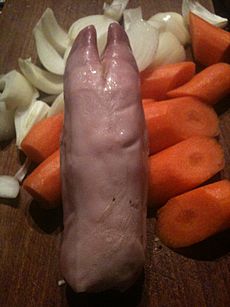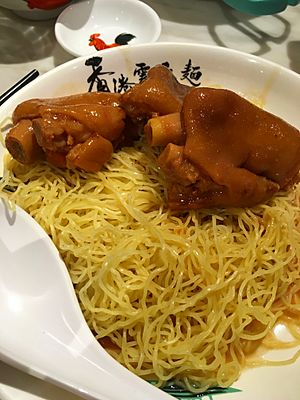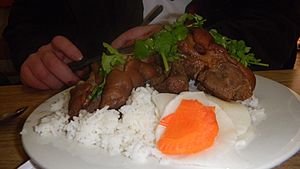Pig's trotter facts for kids
A pig's trotter is the name for a pig's foot used in cooking. It is also sometimes called a pettitoe or pig's foot. People around the world use pig's trotters in many different dishes. They became popular again in the late 2000s.
What Are Pig's Trotters?
Before they are sold, pig's trotters are carefully cleaned. Any hairs are removed using hot water and special tools.
People often use trotters to make stock or gravy. They help make the gravy thicker and richer. You can also serve them as a main part of a meal, just like other cuts of meat.
In Puerto Rico, there is a stew called Patitas de Cerdo. It is made with pig's trotters, chickpeas, and a tomato sauce. Sometimes, people add potatoes or squash to it. In the New York City restaurant Hakata Tonton, many dishes include pig's trotters.
After a time when money was tight in the late 2000s, pig's trotters became very popular in the United Kingdom. People started looking for cheaper ways to cook tasty meals. In 2008, a British supermarket called Waitrose started selling trotters again. They quickly became a favorite item.
In Norway, there is a traditional dish called syltelabb. It is made by salting and boiling pig's feet. This dish was often eaten before Christmas because pigs were usually prepared around that time, and every part of the animal was used.
Dishes Made with Pig's Trotters
Pig's trotters are used in many different recipes around the world. Here are some examples:
- Bean crock (les pais au fou) from Jersey, Channel Islands
- Cappello da prete and Cotechino from Modena, Italy
- Crubeens from Ireland
- Pied de cochon from Sainte-Menehould, France
- Tebichi from Okinawa, Japan
- Tom tin moo from Laos
- Crispy pata, paksiw na pata, and patatim from the Philippines
- Jokbal from Korea
- Souse from Barbados and St. Vincent and the Grenadines
- Spitzbein or Pfoten in German, and golonka in Polish
- Syltelabb from Norway
- Kha mu (meaning "pigs' feet") from Thailand, influenced by Chinese stewed pork
- Patitas con maní and Sarza de patitas from Peru
- Peus de porc from Catalonia
- Manitas de cerdo from Spain
See also
 In Spanish: Manos de cerdo para niños
In Spanish: Manos de cerdo para niños





